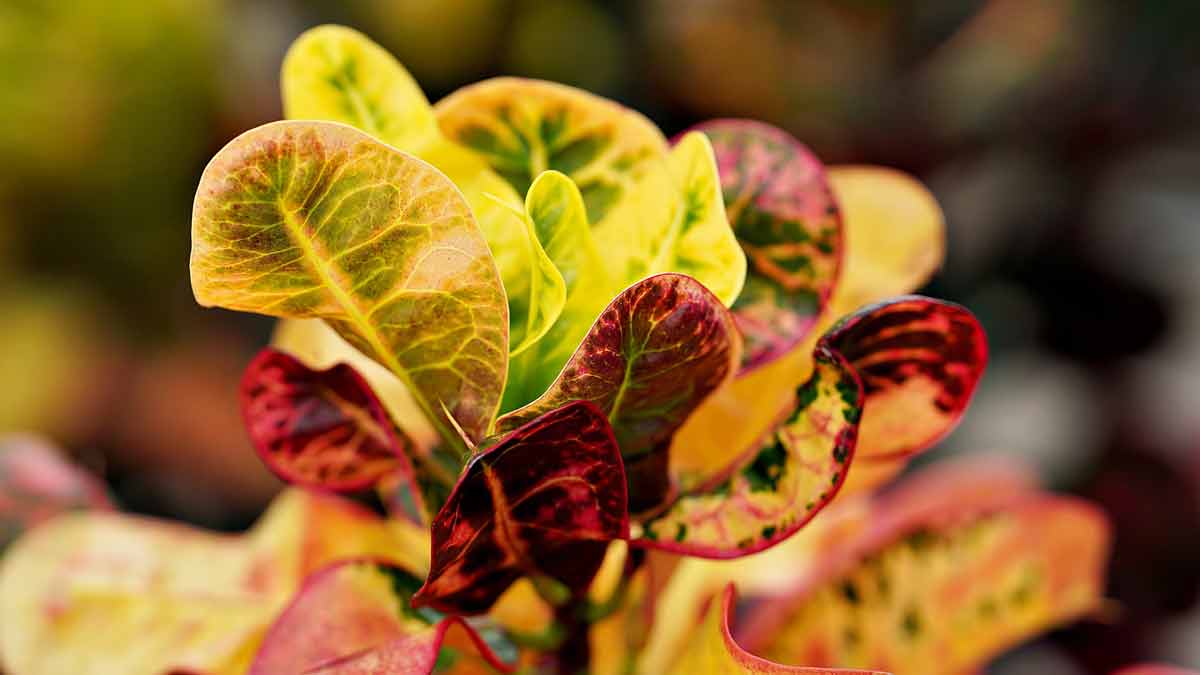Croton plants require frequent watering to keep the soil evenly moist, but avoid overwatering and root rot. Check the soil before watering and ensure good drainage. Water once a week in summer and once every two weeks in winter. Repot every 2-3 years for better nutrition. Crotons like bright sun and drafts should be avoided.
Croton plants, known for their vibrant and colorful leaves, are popular among plant enthusiasts.
However, providing the right amount of water is crucial for maintaining the health and vigor of these stunning tropical houseplants.
In this guide on how often to water croton plants, we will explore various factors that affect their watering requirements and share best practices to ensure your Croton thrives all year round.
Factors Affecting Croton Plants Water Requirements
Various factors affect the water requirements of Croton plants.
These include the type of soil, the level of humidity, the season, the size of the pot, and the amount of light the plant receives.
Understanding these factors is crucial for maintaining a healthy and vibrant Croton plant.
Soil Type
Soil type plays a crucial role in determining the water requirements of croton plants.
These tropical beauties thrive best in well-draining, rich, and slightly acidic soils.
They prevent root rot by allowing excess water to drain away quickly.
When choosing potting soil for your Croton plant care routine, you must consider its ability to retain adequate moisture without becoming soggy or overly compacted.
A suitable blend will help maintain consistent moisture levels while offering proper aeration for robust root development.
Humidity Levels
Humidity levels play a crucial role in the overall health of Croton plants, significantly impacting how often you should water them.
As native tropical plants, crotons thrive best in environments with high humidity, which can be challenging to replicate indoors.
To maintain optimal moisture levels around your Croton plant and minimize its watering requirements, consider placing a tray filled with pebbles and water under the pot or using an indoor humidifier.
It’s essential to understand that lower humidity levels may cause your Croton plant to require more frequent watering than usual.
Conversely, the water needed will naturally decrease during higher humidity—such as in summer.
Season
Seasonal changes have a significant impact on the frequency of watering croton plants.
During the warmer months, when these tropical beauties experience increased growth and transpiration, they generally require more frequent watering to maintain a moist soil environment.
Conversely, during fall and winter seasons – when cooler temperatures prevail and plant growth slows down – it is crucial to reduce your Croton’s watering frequency to about once per week.
This adjustment prevents root rot and other common problems caused by excess water in colder conditions.
Furthermore, consider that indoor environments with central heating systems may have decreased humidity levels throughout the year, necessitating slightly more frequent watering or incorporating additional measures like misting the foliage for optimal Croton care.
Pot Size
The size of the pot plays a crucial role in the watering requirements of croton plants.
A smaller pot will dry out faster, requiring more frequent watering, while a larger pot can hold onto moisture longer and may only need to be watered once per week.
An appropriately sized container for your Croton plant is essential to ensure optimal growth and health.
Repotting every 2-3 years is recommended as it replenishes nutrients and protects them from fertilizer salts that build up over time.
Light Exposure
Croton plants need proper light exposure for optimal growth and development.
They thrive in bright, indirect sunlight, so placing them in a spot where they can receive at least 6-8 hours of sunlight daily is essential.
If the plant doesn’t receive enough light, its leaves may fade or turn yellow.
On the other hand, if it receives too much direct sunlight, the leaves may scorch and dry out.
To avoid this issue, consider placing your Croton plant near a north-facing window with sheer curtains or in an area that receives bright but indirect sunlight throughout the day.
Understanding The Signs Of Overwatering And Underwatering
Overwatering is a common mistake when caring for Croton plants, leading to root rot and other issues.
Signs of overwatering include:
- Wilting or yellowing leaves.
- Brown spots on the foliage.
- A soggy or foul-smelling soil.
To avoid overwatering your Croton plant, let the top inch of the soil dry out before watering again.
Underwatering can be just as harmful to Croton plants as overwatering.
The most noticeable sign of underwatered crops is falling leaves.
Other signs may include crispy or brown edges on leaves or dull coloration on foliage.
Paying attention to its watering needs is crucial to care for your Croton plant and ensuring its longevity properly.
How Often To Water Croton Plants
Croton plants require a proper watering schedule to maintain their health and beauty.
Various environmental factors and seasonal changes can influence the frequency of watering them.
Understanding the ideal watering requirements is essential to ensure their growth and survival.
Watering Frequency For Different Seasons
Proper watering frequency for croton plants varies depending on the season.
In summer, these tropical plants need to be watered about once a week, while in winter, they will only need watering once every two weeks.
In the fall and winter months, it is crucial to reduce the watering frequency as the plant’s growth slows down during this time.
The key is to check the soil’s moisture level before watering and adjust accordingly.
Remember not to let the soil dry out completely or keep the plant sitting in water, as both can harm your Croton plant’s health.
Determining Soil Moisture Using The Finger Test
One way to determine when your Croton plant needs watering is by using the finger test.
Stick your index finger into the soil up to the first knuckle, and if it feels dry, it’s time to water.
If the soil still feels moist, hold off on watering for a few more days.
Remember that overwatering can be as harmful as under-watering, so make sure you’re not giving your Croton too much love (or water).
With its tropical origins, crotons thrive in well-draining soils that are kept slightly moist but never soggy.
Adjusting Watering Frequency Based On Environmental Factors
Croton plants are sensitive to their environment, and adjusting the watering frequency in response to changing conditions is critical for their health.
Temperature and humidity levels, among other factors, can affect a Croton’s water requirements.
Another environmental factor that affects watering frequency is light exposure.
Crotons thrive under bright sunlight but can suffer if exposed to direct sunlight for extended periods or inconsistent lighting conditions.
In such cases, monitoring soil moisture levels closely and adjusting watering frequency accordingly is best.
Caring for croton plants involves adjusting your watering regimen based on several environmental factors and knowing how often to water them throughout different seasons.
Best Practices For Watering Croton Plants
If you want your Croton plants to flourish, you must follow some best practices.
These practices include watering the soil, not the foliage, using room-temperature water, and avoiding over-watering or letting the soil dry out completely.
Additionally, ensure the plant is not sitting in water to prevent root rot. Following these guidelines will help you maintain healthy and vibrant Croton plants.
Using Room-temperature Water
It is important to use room-temperature water when watering your Croton plants.
Cold water can shock the roots and cause damage, while hot water can scald them.
Using lukewarm or room temperature water will prevent any harm and help keep the plant healthy.
You can let tap water sit for a few hours before using it to allow it to reach room temperature naturally, or you could warm it up in a kettle if necessary.
Watering The Soil, Not The Foliage
When watering croton plants, focusing on the soil rather than the foliage is important.
This means pouring water directly onto the soil and avoiding getting any water on the leaves.
Wet foliage can lead to fungal diseases or even leaf burn when exposed to direct sunlight.
To properly water your Croton plant, use a watering can instead of spraying or misting the plant with a hose.
This allows for more precise application of water where it’s needed most – at the roots.
Also, ensure you are not letting your plant sit in standing water, which can cause root rot and other problems.
Using A Watering Can
One of the best practices for watering croton plants is to use a watering can instead of pouring water directly onto the soil.
This helps prevent excess water from flowing out and damaging the roots or causing soil erosion.
It also allows you to control the amount of water your plant receives, ensuring that it is just enough for proper growth.
Use room-temperature water, as cold water can shock the roots, while hot water can damage them.
It’s important not to let your Croton plant sit in standing water after each watering session; otherwise, this could cause root rot and kill your plant eventually.
Avoiding Letting The Soil Dry Out Completely
Keeping the soil in your Croton plant’s container consistently moist is important, but avoid letting it dry out completely.
Allowing the soil to become bone-dry can cause stress and damage to the plant, leading to leaf loss or even death.
To prevent this, check the soil moisture regularly by sticking your finger about an inch into the potting mix.
If it feels dry at that depth, it’s time to water.
Additionally, aim for a regular watering schedule based on environmental factors like humidity and temperature.
Making Sure The Plant Is Not Sitting In Water
It is important to avoid letting your Croton plant sit in water as it can lead to root rot and other issues.
To prevent this from happening, make sure that any excess water is drained away after watering.
You can do this by placing a saucer under the pot and emptying it after 10-15 minutes once the soil has absorbed enough moisture.
Another option is to use a well-draining potting mix for proper drainage.
Final Thoughts
Watering croton plants may seem simple, but it requires careful consideration of various factors.
From soil type and pot size to humidity levels and light exposure, all these elements are crucial in determining how often you should water your plant.
It’s essential to understand the signs of overwatering and underwatering and adjust your watering frequency accordingly.
Following our best practices for watering Croton plants, you can keep them healthy, happy, and vibrant throughout the year.







